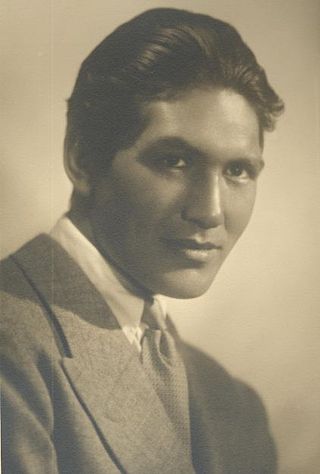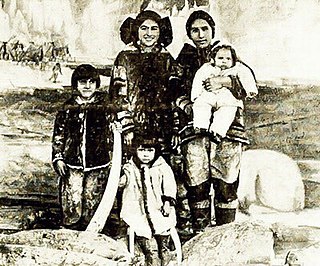
Knud Johan Victor Rasmussen was a Greenlandic-Danish polar explorer and anthropologist. He has been called the "father of Eskimology" and was the first European to cross the Northwest Passage via dog sled. He remains well known in Greenland, Denmark and among Canadian Inuit.

Nanook of the North is a 1922 American silent film that combines elements of documentary and docudrama/docufiction, at a time when the concept of separating films into documentary and drama did not yet exist. In the tradition of what would later be called salvage ethnography, the film follows the struggles of the Inuk man named Nanook and his family in the Canadian Arctic. It is written and directed by Robert J. Flaherty, who also served as cinematographer, editor, and producer.

Ellesmere Island is Canada's northernmost and third largest island, and the tenth largest in the world. It comprises an area of 196,236 km2 (75,767 sq mi), slightly smaller than Great Britain, and the total length of the island is 830 km (520 mi).
The Sun and the Moon is an unipkaaqtuat, a story in Inuit folklore. The traditional explanation for the movement of the Sun and Moon through the sky is that a brother and sister are constantly chasing each other across the sky. The story also explains the moon's dappled gray appearance as soot smeared on his face.

The Inupiat are a group of Alaska Natives whose traditional territory roughly spans northeast from Norton Sound on the Bering Sea to the northernmost part of the Canada–United States border. Their current communities include 34 villages across Iñupiat Nunaat, including seven Alaskan villages in the North Slope Borough, affiliated with the Arctic Slope Regional Corporation; eleven villages in Northwest Arctic Borough; and sixteen villages affiliated with the Bering Straits Regional Corporation. They often claim to be the first people of the Kauwerak.

Vilhjalmur Stefansson was an Arctic explorer and ethnologist. He was born in Manitoba, Canada.

The Canadian Eskimo Dog or Canadian Inuit Dog is a breed of working dog from the Arctic. Other names include qimmiq or qimmit. The Greenland Dog is considered the same breed as the Canadian Eskimo Dog since they have not yet diverged enough genetically to be considered separate breeds, despite their geographic isolation.

The Selig Polyscope Company was an American motion picture company that was founded in 1896 by William Selig in Chicago, Illinois. The company produced hundreds of early, widely distributed commercial moving pictures, including the first films starring Tom Mix, Harold Lloyd, Colleen Moore, and Roscoe "Fatty" Arbuckle. Selig Polyscope also established Southern California's first permanent movie studio, in the historic Edendale district of Los Angeles.

Ray Mala was a prominent Alaska Native actor. He was one of Hollywood's Native American movie actors along with Lillian St. Cyr, Jesse Cornplanter, Chief Yowlachie, William Eagle Shirt, and Will Rogers who also had successful careers during that time. Mala's career peaked in the 1930s and he was best known for his lead role in Republic Pictures' 14-part serial Robinson Crusoe of Clipper Island (1936) following his feature role in MGM's Eskimo, directed by Woody Van Dyke. He was named a "Top Ten Alaskan" by TIME Magazine in 2009.

The Inughuit, or the Smith Sound Inuit, historically Arctic Highlanders or Polar Eskimos, are Greenlandic Inuit. They are the northernmost group of Inuit and the northernmost people in North America, living in Greenland. Inughuit make up about 1% of the population of Greenland.

The Netsilik (Netsilingmiut) are Inuit who live predominantly in Kugaaruk and Gjoa Haven, and somewhat in Taloyoak of the Kitikmeot Region, Nunavut, and, to a smaller extent in the north Qikiqtaaluk Region, in Canada. They were, in the early 20th century, among the last northern indigenous peoples to encounter missionaries from the south.

Inuit art, also known as Eskimo art, refers to artwork produced by Inuit, that is, the people of the Arctic previously known as Eskimos, a term that is now often considered offensive. Historically, their preferred medium was walrus ivory, but since the establishment of southern markets for Inuit art in 1945, prints and figurative works carved in relatively soft stone such as soapstone, serpentinite, or argillite have also become popular.

The Immortal Alamo is an American silent film released on May 25, 1911. The Immortal Alamo is the earliest film version of the events surrounding the 1836 Battle of the Alamo. The film was directed by William F. Haddock and produced by Gaston Méliès. The film's cast included Francis Ford, Edith Storey, William A. Carroll, and one hundred cadets from the Peacock Military Academy. The film was said to be 10 minutes in length and focused on the formula of "pretty girl, shy hero, and a villain" during the battle.

Inuit are a group of culturally and historically similar Indigenous peoples traditionally inhabiting the Arctic and subarctic regions of North America, including Greenland, Labrador, Quebec, Nunavut, the Northwest Territories, Yukon (traditionally), Alaska, and Chukotsky District of Chukotka Autonomous Okrug, Russia. Inuit languages are part of the Eskimo–Aleut languages, also known as Inuit-Yupik-Unangan, and also as Eskaleut. Inuit Sign Language is a critically endangered language isolate used in Nunavut.
Hugh Brody is a British anthropologist, writer, director and lecturer.

Louella Maxam was an American actress who performed in over 50 silent films from 1913 until 1921. She was often cast in comedies and Westerns, most notably being identified in 1915 as a "leading lady" in a series of shorts starring Tom Mix, who during the silent and early sound eras was promoted as the "Cowboy King of Hollywood". Later, she was a female lead in other films for various studios, including several productions featuring another early cowboy star, Franklyn Farnum. Following her departure from acting, Maxam worked in county and municipal government in California, including service with the Burbank police department, where in 1943 she was hired as that city's first "police woman".

The Witch is a lost 1916 American silent drama film directed by Frank Powell, produced by Fox Film Corporation, and starring Nance O'Neil, Alfred Hickman, and Frank Russell. Based on the 1903 play La Sorcière by French dramatist Victorien Sardou, this adaptation portrayed the challenges facing a young woman living in a territory in Mexico wracked by military and social unrest. It was filmed at Fox's studio in Fort Lee, New Jersey, where a Mexican village was constructed on the company's backlot and used as the principal set for outdoor scenes.

The Way of the Eskimo is a lost 1911 American silent drama film that portrayed the Inuit or "Eskimo" culture of northeastern Canada along the coast of Labrador. Directed by William V. Mong and produced by Selig Polyscope Company, this "photoplay" was based on a love story written by Columbia Eneutseak, a young Inuit woman who was born in the United States in 1893, in the "Esquimaux Village" exhibition at the World's Columbian Exposition in Chicago. She, fellow Inuit performer Zacharias Zad, and William Mong costarred in the film with a supporting cast that included members of Columbia's immediate family and other Inuit players. While this production was promoted in 1911 as being filmed on location in northern Canada, it was actually shot that year at the snow-covered port town of Escanaba, Michigan, along a frozen stretch of shoreline of Little Bay de Noc, which connects to Lake Michigan.

Columbia Eneutseak, also billed as Nancy Columbia, was an American performer in silent films, known for writing and starring in The Way of the Eskimo (1911).

Esther Eneutseak (1877–1961) was an Inuk performer and actor. Originally from Nain, Labrador, she performed at "Inuit villages" at world's fairs and circuses, and in films with her daughter, Columbia Eneutseak. Her self-chosen surname means "good person".



















